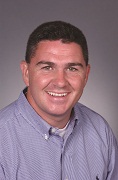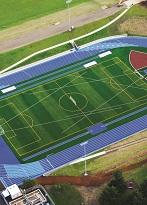
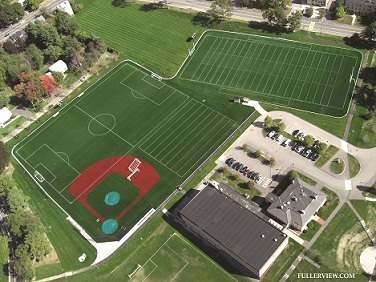 |
| Photo courtesy of Stantec, Boston, MA |
Three-season athletes. Multi-tasking employees. Some things are just better when they can address more than one need.
The latest entry into this list is the multi-purpose (or multi-sport) field, a facility with dimensions and markings to accommodate a variety of sports. Increasingly, schools, universities, parks and more are moving to this model of athletic facility. It allows fields to host more games, and in the case of artificial turf fields, more often.
Within the sports planning industry, we can expect to see an increasing number of fields marked for multiple uses: football, soccer, lacrosse, field hockey and more. And with the advent of rugby as a new sport in the 2016 Summer Olympics (see our Executive Insights article), we may very well be seeing even more sports, and more lines.
If sports planners are hesitant about this concept, though, two industry experts are ready to reassure them. Patrick Maguire, MLA, RLA, CLARB, LEED AP®, and Mark J. Novak, RLA, of Activitas Inc., which specializes in planning, landscape architecture and athletic facilities, can provide some insights into multi-use fields.
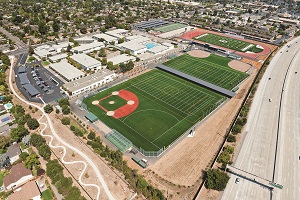 |
| Photo courtesy of Verde Design, Inc., Santa Clara, California |
What are the advantages to having multi-purpose fields?
It's really a cost-effective way to get more events on the ground, and that does make sense if someone wants to make back the money that went into having the facility built. Something else to consider is the fact that you can host not just two, three or more sports, but even tournaments for smaller and younger kids where the field size is different. You have to have the ability to be much more flexible.
It's great for field owners, but what about the athletes? Do they have any reservations about playing on a field marked with multiple lines?
It has been our experience that the athletes are not that distracted by it. They seem to be more focused on playing. There might be lines for soccer, football, lacrosse -- but when you're actually on the field and in a game, it's is like the other lines disappear. You instinctively know where you need to be once the whistle blows. Now, if you step back and look at it from a spectator's standpoint, a lot of markings can be very distracting. We sometimes hear people say they see a ton of lines out there, and that it looks like a giant bowl of spaghetti. But again, the athletes don't appear to see it that way. If they have a chance to get out there on the field and warm up before the game, they're even less affected by it.
What about referees? Are they confused by it?
Not really. It's seems to be the same for officials as it is for the athletes -- they know where the lines are and where the players should be.
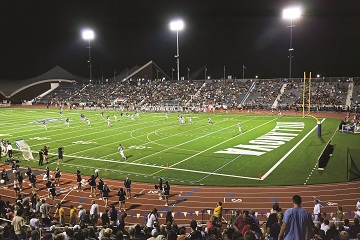 |
| Photo courtesy of Stantec, Boston, MA |
Are there any specific rules concerning line colors?
It depends on the sports being hosted. What commonly happens is that lines for football are almost exclusively going to be white. The other sports will generally play off that, using other colors. Soccer is commonly yellow. After that comes lacrosse, field hockey and so on, and you can be more flexible choosing those colors. We've seen men's lacrosse fields lined in blue, and women's lines in some variation of red, such as maroon or purple. Field hockey might be black. It can vary, of course. Field hockey rules state that the lines need to be white, but that rarely happens unless you have a field that is specifically for field hockey and nothing else. Something you need to understand as a designer is which sport is predominant, which sports will be hosted, and whether or not all those sports have been accounted for. Line paints can be temporary or permanent.
Are there ever any problems with that?
The only confusion comes when you have various sports, and the lines come up right next to each other.
As more communities become increasingly developed and land-locked, there is less room to build sports facilities in communities, but of course, the need for sports facilities is still there. Does this lead to creative design?
Something we're seeing is the combination of baseball and softball with other sports, such as soccer and football. Baseball may be a whole different animal, but it is trying hard to accommodate other sports by sharing field space. It really does make sense if your field space is limited. Consider the sheer size of a baseball field, and you understand that it would be a shame to put in a synthetic turf outfield, and then use that only during certain months of the year. At the moment, we're actually working on a minor league baseball park, and we are doing all kinds of gymnastics in order to have a legitimate baseball field, as well as soccer for the community. It might not be ideal for some professional facilities, but there are places where it can work very well. Sometimes, these multi-use fields can be quirky, and it's our job to make sure quirky doesn't lead to outrageous dimensions. Everything still has to be usable, and if it's a field used for competition, the dimensions need to conform to the rules of the governing bodies.
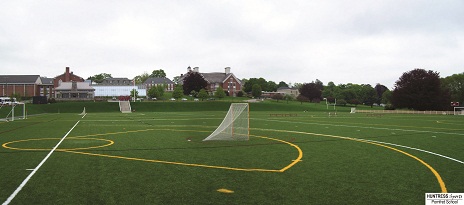 |
| Photo courtesy of Huntress Associates, Inc., Andover, MA |
Many of the multi-purpose facilities being built now are synthetic turf because they can withstand constant use, and can be ready for use in almost any season, barring precipitation. Are they ideal for all sports?
It really varies from sport to sport. If a field is multi-use, a planner should be asking what kind of surface it has (meaning what product), and thinking about what type of roll the ball will take as a result. It's also helpful to ask what other sports are being played on the field.
Are you seeing more fields that are synthetic turf, or more that are natural grass?
There's still a mixture of grass and synthetic fields out there. Grass is less expensive, obviously, and if it can be kept in good condition, it's great. Unfortunately, if a lot of games will be held back-to-back, it can be too much wear on the field. We do see a lot of synthetic turf fields being used for multiple sport facilities because so many games can be run across them over the course of one day.
What else should a planner be looking for?
You want to look at what kind of amenities there are for players. Are there places for them to sit in the shade? Are there bathroom facilities, and if so, how easy is it for them to get back and forth? Are there places for them to eat lunch, or buy lunch? Is there adequate parking at the site? If you have a rainy day, is there an indoor facility that can be used for games?
Something we always tell people is that additional warm-up and training space is very important. If you have six fields at the facility you're using, and you have 12 games that are going to be played during the course of the day, you need to have places for those six other teams to warm up while they're waiting to play. Therefore, you really need space that is close by, as well as flexible. For example, the tournament itself might be held at the baseball complex, but other facilities are going to be used for warm-ups, such as fields on the campuses of nearby colleges or high schools. You want to make sure they're close to where the actual tournament will be held. That goes for hotels too; everything should be conveniently located.
If you have a multi-purpose field, you might have kids who learn to play on it, and they can go on to use the fields for rec league and high school play. It's everyone's home field, and everyone shares the fruits of the players' development from using that field.


